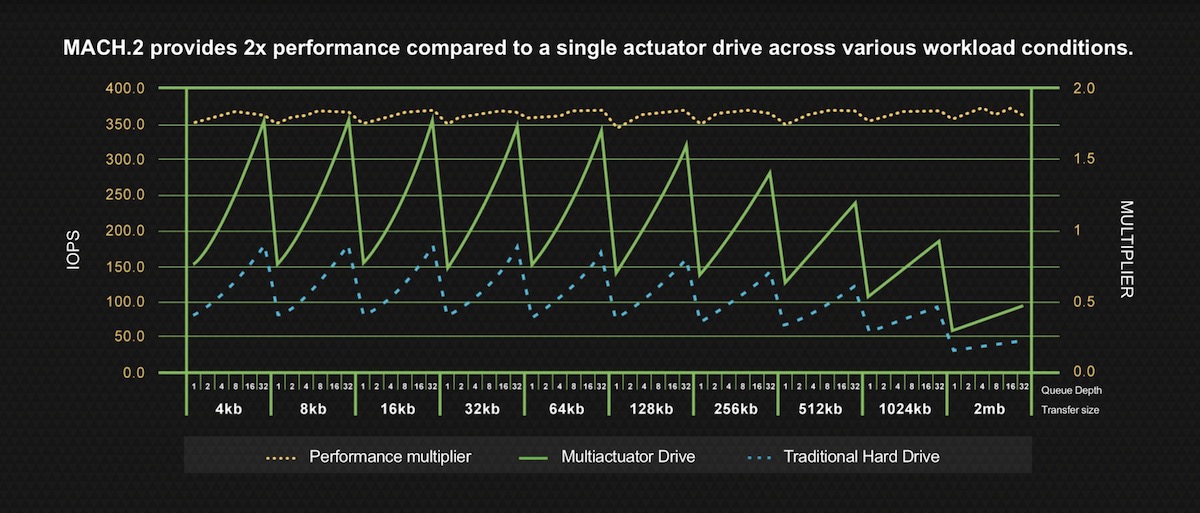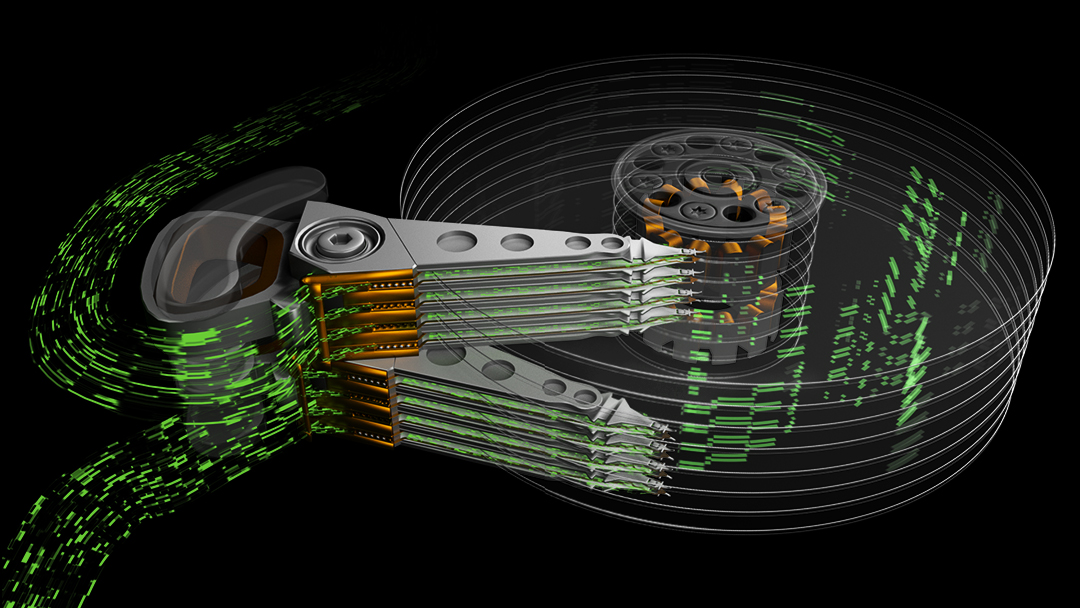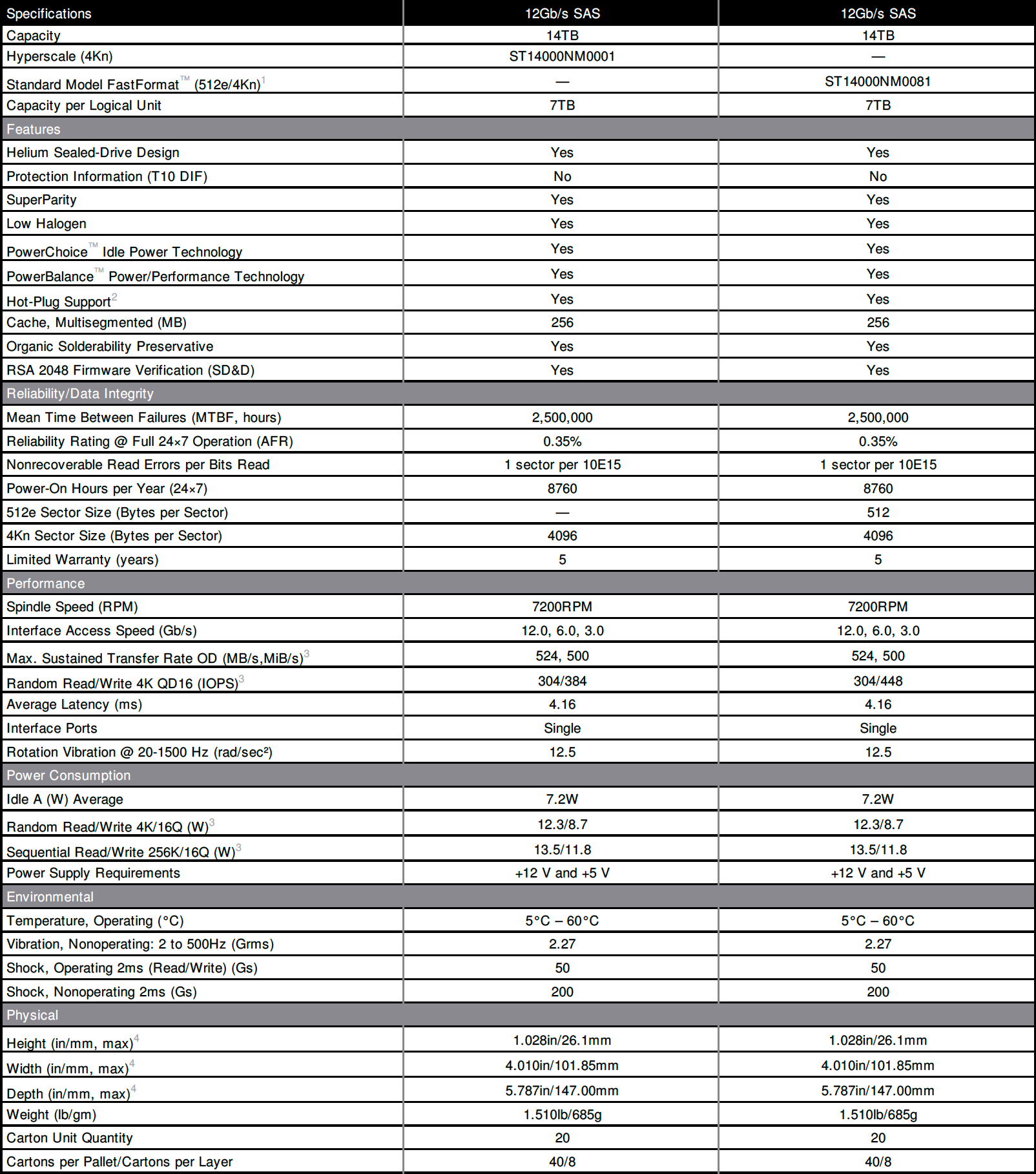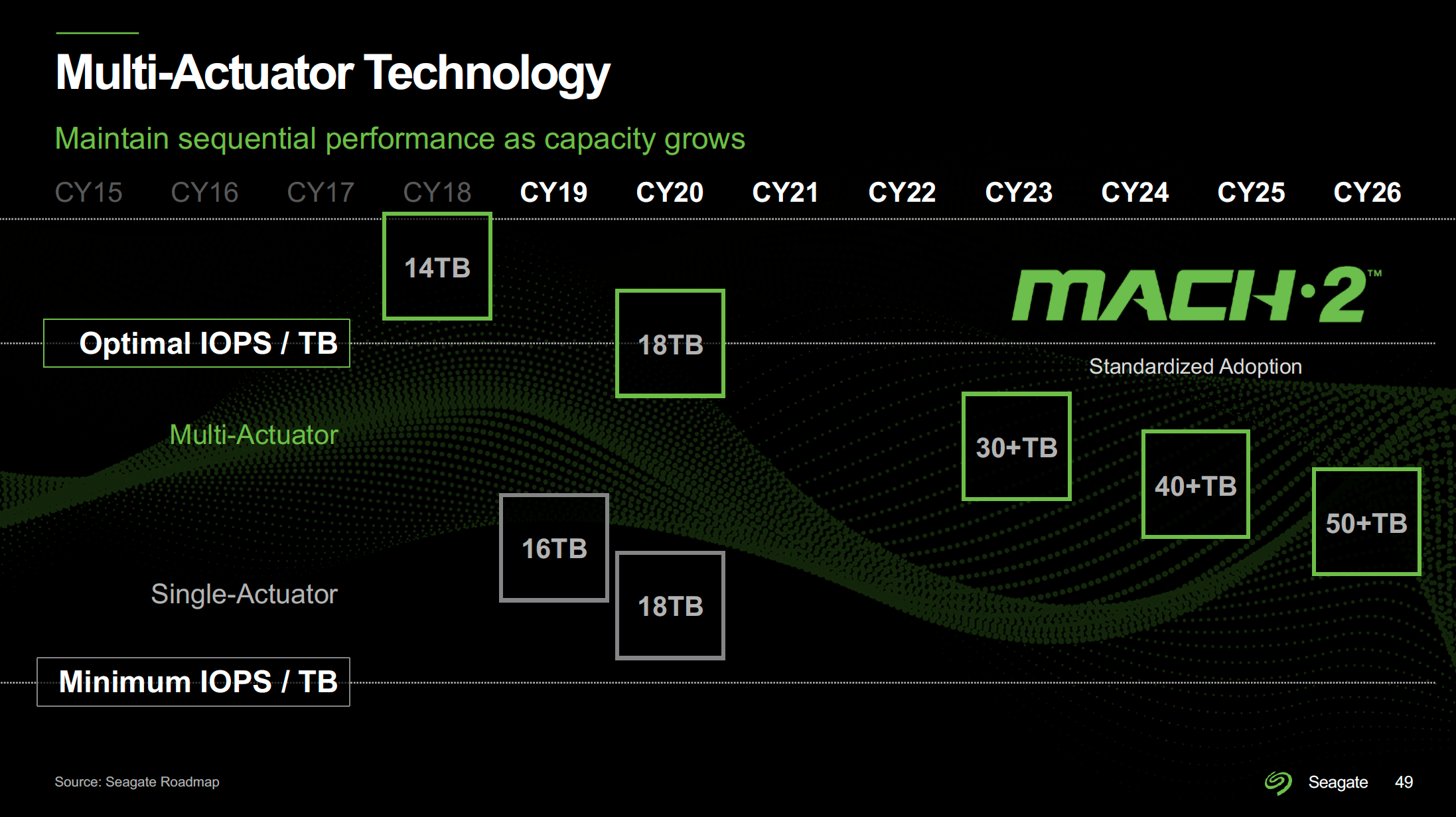Seagate Lists the Mach.2: The World's Fastest HDD
The Mach.2 delivers up to 524 MB/s of sequential throughput
Seagate has finally listed its dual-actuator hard disk drive — the Mach.2 Exos 2X14 — on its website and disclosed the official specs. With a 524MB/s sustained transfer rate, the Mach.2 is the fastest HDD ever, its sequential read and write performance is twice that of a normal drive. In fact, it can even challenge some inexpensive SATA SSDs.
The HDD is still available to select customers and will not be available on the open market, at least for the time being. Meanwhile, Seagate's spec disclosure shows us what type of performance to expect from multi-actuator high-end hard drives.
Seagate Describes First Mach.2 HDD: the Exos 2X14
Seagate's Exos 2X14 14TB hard drive is essentially two 7TB HDDs in one standard hermetically sealed helium-filled 3.5-inch chassis. The drive features a 7200 RPM spindle speed, is equipped with a 256MB multisegmented cache, and uses a single-port SAS 12Gb/s interface. The host system considers an Exos 2X14 as two logical drives that are independently addressable.
Seagate's Exos 2X14 boasts a 524MB/s sustained transfer rate (outer diameter) of 304/384 random read/write IOPS, and a 4.16 ms average latency. The Exos 2X14 is even faster than Seagate's 15K RPM Exos 15E900, so it is indeed the fastest HDD ever.
Furthermore, its sequential read/write speeds can challenge inexpensive SATA/SAS SSDs (at a far lower cost-per-TB). Obviously, any SSD will still be faster than any HDD in random read/write operations. However, hard drives and solid-state drives are used for different storage tiers in data centers, so the comparison is not exactly viable.
But performance increase comes at the cost of higher power consumption. An Exos 2X14 drive consumes 7.2W in idle mode and up to 13.5W under heavy load, which is higher than modern high-capacity helium-filled drives. Furthermore, that's also higher than the 12W usually recommended for 3.5-inch HDDs.
Seagate says the power consumption is not an issue as some air-filled HDDs are power hungry too, so there are plenty of backplanes and servers that can deliver enough power and ensure proper cooling. Furthermore, the drive delivers quite a good balance of performance-per-Watt and IOPS-per-Watt. Also, data centers can use Seagate's PowerBalance capability to reduce power consumption, but at the cost of 50% lower sequential read/write speeds and 5%~10% lower random reads/writes.
"3.5-inch air-filled HDDs have operated in a power envelope that is very similar to Exos 2X14 for many years now," a spokesman for Seagate explained. "It is also worth noting that Exos 2X14 does support PowerBalance which is a setting that allows the customer to reduce power below 12W, [but] this does come with a performance reduction of 50% for sequential reads and 5%-10% for random reads."
Since the Exos 2X14 is aimed primarily at cloud data centers, all of its peculiarities are set to be mitigated in one way or another, so slightly higher power consumption is hardly a problem for the intended customers. Nonetheless, the drive will not be available on the open market, at least for now.
Seagate has been publicly experimenting with dual-actuator HDDs (dubbed Mach.2) with Microsoft since late 2017, then it expanded availability to other partners, and earlier this year, it said that it would further increase shipments of such drives.
Broader availability of dual-actuator HDDs requires Seagate to better communicate its capabilities to customers, which is why it recently published the Exos 2X14's specs.
"We began shipping [Mach.2 HDDs] in volume in 2019 and we are now expanding our customer base," said Jeff Fochtman, Senior Vice President, Business and Marketing, Seagate Technology. "Well over a dozen major customers have active dual-actuator programs underway. As we increase capacities to meet customer needs, Mach.2 ensures the performance they require by essentially keeping the drive performance inside the storage to your expectations for hyperscale deployments."
Get Tom's Hardware's best news and in-depth reviews, straight to your inbox.
Keeping HDDs Competitive
Historically, HDD makers focused on capacity and performance: every new generation brought higher capacity and slightly increased performance. When the nearline HDD category emerged a little more than a decade ago, hard drive makers added power consumption to their focus as tens of thousands of HDDs per data center consumed loads of power, and it became an important factor for companies like AWS, Google, and Facebook.
As hard drive capacity grew further, it turned out that while normal performance increments brought by each new generation were still there, random read/write IOPS-per-TB performance dropped beyond comfortable levels for data centers and their quality-of-service (QoS) requirements. That's when data centers started mitigating HDD random IOPS-per-TB performance with various caching mechanisms and even limiting HDD capacities.

In a bid to keep hard drives competitive, their manufacturers have to continuously increase capacity, increase or maintain sequential read/write performance, increase or maintain random read/write IOPS-pet-TB performance, and keep power consumption in check. A relatively straightforward way to improve the performance of an HDD is to use more than one actuator with read/write heads, as this can instantly double both sequential and random read/write speeds of a drive.
Not for Everyone. Yet
Seagate is the first to commercialize its dual-actuator HDD, but its rivals from Toshiba and Western Digital are also working on similar hard drives.
"Although Mach.2 is ramped and being used now, it's also really still in a technology-staging mode," said Fochtman. "When we reach capacity points above 30TB, it will become a standard feature in many large data center environments."
For now, most of Seagate's data center and server customers can get a high-capacity single-actuator HDD with the right balance between capacity and IOPS-per-TB performance, so the manufacturer doesn't need to sell its Exos 2X14 through the channel. Meanwhile, when capacities of Seagate's HAMR-based HDDs increase to over 50TB sometime in 2026, there will be customers that will need dual-actuator drives.

Anton Shilov is a contributing writer at Tom’s Hardware. Over the past couple of decades, he has covered everything from CPUs and GPUs to supercomputers and from modern process technologies and latest fab tools to high-tech industry trends.
-
escksu HDDs are here to stay for a long long time. Their capacity, cost per MB cannot be matched by SSD. Its also not affected by repeated writes unlike SSD. Of course they are much slower than SSD. But when capacity matters, the trade-off is reasonable.Reply -
sepuko The news should read "The fastest Chia miner is now available but not to you and not at any sane prices"Reply -
smaddeus Reply
Not only that, but SSD's have a quite significantly lower lifespan than HDD's, because manufacturers keep on increasing bits per cell, and more bits per cell there are, the shorter lifespan there is for it, not sure how it works, but it is a fact that SLC (single-bit cell) is more durable, but more expensive as well. Where your HDD, if not faulty from factory, or is being carried somewhere at some point and shaken around, can last basically for a decade and more. I had a WD Green, of course it had 5400rpm, or I think it had the Inteli, which is a variable, if not mistaken. It lasted easily 8 years before I sold off with my old rig 2 years ago. It probably still lives and can keep on living.escksu said:HDDs are here to stay for a long long time. Their capacity, cost per MB cannot be matched by SSD. Its also not affected by repeated writes unlike SSD. Of course they are much slower than SSD. But when capacity matters, the trade-off is reasonable.
Now I have SG Barracuda, 2x of them, both 2TB's, and it does the job just fine so far. Hopefully it will remain to work fine for a loong time, unless this Mach.2 is available, then I might switch them or get a case with more bracket slots. -
USAFRet Reply
And the last WD Green I had died at 5 weeks out of the box.smaddeus said:Not only that, but SSD's have a quite significantly lower lifespan than HDD's, because manufacturers keep on increasing bits per cell, and more bits per cell there are, the shorter lifespan there is for it, not sure how it works, but it is a fact that SLC (single-bit cell) is more durable, but more expensive as well. Where your HDD, if not faulty from factory, or is being carried somewhere at some point and shaken around, can last basically for a decade and more. I had a WD Green, of course it had 5400rpm, or I think it had the Inteli, which is a variable, if not mistaken. It lasted easily 8 years before I sold off with my old rig 2 years ago. It probably still lives and can keep on living.
Now I have SG Barracuda, 2x of them, both 2TB's, and it does the job just fine so far. Hopefully it will remain to work fine for a loong time, unless this Mach.2 is available, then I might switch them or get a case with more bracket slots.
Lifespan comparisons between HDD and SSD depend a LOT on use case.
I'll certainly never go back to HDD for main use systems.
My NAS, OTOH....65TB won't be replaced by SSD anytime soon. -
Co BIY Why do the heads move together ? Seems like independent heads would be better ?Reply
Why not multiple heads on a single disk (double heads per platter) ?
Do any HDDs have any warning mechanism to warn of failure before your data is at risk ? -
USAFRet Reply
That is specifically what SMART isCo BIY said:Do any HDDs have any warning mechanism to warn of failure before your data is at risk ?
https://www.digitalcitizen.life/simple-questions-what-smart-what-does-it-do/
Data density. No matter how many heads there, you can only squeeze so much data into so many square inches.Co BIY said:Why not multiple heads on a single disk (double heads per platter) ?
Because it is a spinning platter, things have to 'wait' until the desired data has come around to where the relevant head is. -
jeremyj_83 Reply
That isn't true at all for enterprise grade or consumer grade drives. When it comes to 7200RPM enterprise grade drives, those are warrantied to 550TB/year and that is what the actuator is able to handle. Put that over 5 years as is standard and the drive has a 2.75PB write endurance. Lets say that HDD was 15TB so we would need the information from a 15.36TB Enterprise SSD. At this point in time the manufacturers consider 1DWPD to be "read intensive" that 15.36TB SSD has a 28PB write endurance. Even a small 1.92TB SSD has a higher endurance than the HDD. Note those are TLC drives. For consumer drives I have never had an SSD fail. My current desktop has been using the same 240GB SSD for 8 years now and it is no where close to being dead.smaddeus said:Not only that, but SSD's have a quite significantly lower lifespan than HDD's, because manufacturers keep on increasing bits per cell, and more bits per cell there are, the shorter lifespan there is for it, not sure how it works, but it is a fact that SLC (single-bit cell) is more durable, but more expensive as well. Where your HDD, if not faulty from factory, or is being carried somewhere at some point and shaken around, can last basically for a decade and more. I had a WD Green, of course it had 5400rpm, or I think it had the Inteli, which is a variable, if not mistaken. It lasted easily 8 years before I sold off with my old rig 2 years ago. It probably still lives and can keep on living.
Now I have SG Barracuda, 2x of them, both 2TB's, and it does the job just fine so far. Hopefully it will remain to work fine for a loong time, unless this Mach.2 is available, then I might switch them or get a case with more bracket slots. -
USAFRet Reply
Also, don't rely on software to warn you of impending doom.Co BIY said:Do any HDDs have any warning mechanism to warn of failure before your data is at risk ?
Expect it to happen, and be proactive with your data backups. -
Umfriend Reply
It would be in line with the accuracy Tom's has had sofar in reporting on Chia. Chia aren't mined, they're farmed.sepuko said:The news should read "The fastest Chia miner is now available but not to you and not at any sane prices" -
watzupken Reply
Over the years, prices of SSD have come down quite a fair bit. I recall when I first got the Intel X25 Gen 2, that 160GB is 4 or 5 times more than a hard drive with more storage capacity. Nowadays, you may be able to find good 2TB SATA3 SSDs at 2.5x the price of a good 2TB mechanical drive.smaddeus said:Not only that, but SSD's have a quite significantly lower lifespan than HDD's, because manufacturers keep on increasing bits per cell, and more bits per cell there are, the shorter lifespan there is for it, not sure how it works, but it is a fact that SLC (single-bit cell) is more durable, but more expensive as well. Where your HDD, if not faulty from factory, or is being carried somewhere at some point and shaken around, can last basically for a decade and more. I had a WD Green, of course it had 5400rpm, or I think it had the Inteli, which is a variable, if not mistaken. It lasted easily 8 years before I sold off with my old rig 2 years ago. It probably still lives and can keep on living.
Now I have SG Barracuda, 2x of them, both 2TB's, and it does the job just fine so far. Hopefully it will remain to work fine for a loong time, unless this Mach.2 is available, then I might switch them or get a case with more bracket slots.
In terms of longevity, if you are just looking at the magnetic platter vs NAND, in theory, the NAND fares a lot worst. But in real life usage, even a good drive have a higher failure rate than a good SSD in my experience. My Intel X25 G2 160GB is still alive and kicking after many years of usage installing OS, apps and games over and over again. The health according to the SMART reading is still 98%, just 2% spent after 10 years. In short, the magnetic platter will survive a lot of writes, but its the other moving parts that will wear out. And also, my WD Green 500GB died after close to a year.


